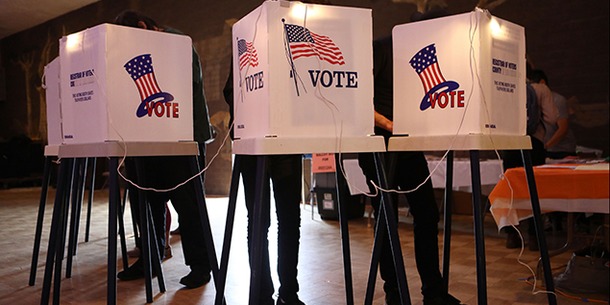Read our 2018 Democracy report here.
In recent elections, we have seen images of Americans waiting for hours to cast a ballot. In the 2012, over 5 million voters waited more than an hour, and another 5 million waited between 30 minutes and an hour.[1] Unsurprisingly, many gave up. One study estimated that in Florida, long lines likely discouraged 200,000 from casting a ballot.[2]
A number of factors may contribute to long lines, but recent Brennan Center research indicates the way election officials allocate their resources is especially important. Our 2014 study of long lines in three states found the polling places with the longest lines had fewer machines and/or fewer workers than other voting sites.
In Florida, for example, the 10 precincts with the longest lines had nearly half as many poll workers per voter as the statewide average. On top of that, the analysis found African Americans and Hispanics were significantly more likely to wait in long lines, and to vote at precincts with fewer machines and personnel.[3] In South Carolina, for example, the 10 precincts with the longest lines had more than twice as many African-American voters. In Maryland, the 10 precincts with the lowest number of voting machines per voter had more than twice as many Hispanic voters.[4]
Proposal
Proper resource allocation is one way to reduce long lines. The Brennan Center found precincts with the longest lines have fewer machines and poll workers. Yet, even states such as South Carolina and Maryland, which instituted resource allocation requirements to alleviate long lines, had some precincts ignore the state requirements.
State election officials should set standards to ensure all polling places have sufficient resources — and create strong oversight mechanisms to ensure precincts adhere to the policy. They should also pay special attention to precincts with high numbers of minority voters, which often have insufficient numbers of machines and poll workers.
There are two bills pending in Congress concerning long lines. The LINE Act, introduced by Sen. Barbara Boxer (D-Calif.), would direct the attorney general to work with the Election Assistance Commission to set federal standards for resource distribution so that no voter has to wait more than one hour.[5] The FAST Voting Act, introduced by Sens. Chris Coons (D-Del.) and Mark Warner (D-Va.), would create a competitive grant program to encourage states to reduce wait times.[6]
Why This Can Be Achieved
Reforms to end long lines have been endorsed by a bipartisan commission. Many Americans were outraged by the hours-long lines in the 2012 election. In his speech that night, President Obama proclaimed, “We have to fix that.” A few months later he formed the Presidential Commission on Election Administration — chaired by former counsels from his and Romney’s campaigns — to address the problem. The Commission recommended a variety of reforms to keep voting wait times to 30 minutes or less.
As the leading democracy of the world, our voting system should be free, fair, and accessible to all eligible Americans. That means ensuring no eligible citizen has to wait hours to cast a ballot.
Resources
- Election Day Long Lines: Resource Allocation: In-depth examination of precinct-level data in three states where voters faced some of the longest lines in 2012: Florida, Maryland, and South Carolina. Study shows what role race played in predicting where lines might develop and how machine and poll worker distribution contributes to long lines.
- The Case for Automatic, Permanent Voter Registration: Details the key components of the plan to sign up every eligible American to vote and explains the transformative benefits of a modern voter registration system.
- Voter Registration in a Digital Age: 2015 Update: As technology has advanced, a growing number of states are using 21st century methods to register voters. This report highlights experiences from the 38 states using electronic and/or online registration, which can boost registration rates, increase accuracy, and save money.
Next: Prioritize Increasing Voter Turnout
[1] The Presidential Comm’n on Election Admin., The American Voting Experience: Report and Recommendations of the Presidential Commission on Election Administration 13 (2014), available at https://www. supportthevoter.gov/files/2014/01/Amer-Voting-Exper-final-draft-01–09–14–508.pdf.
[2] Lawrence Norden, Brennan Ctr. for Justice, How to Fix Long Lines 1 (2013), available at https://www.brennancenter.org/sites/default/files/publications/How_to_Fix_Long_Lines.pdf; Scott Powers & David Damron, Analysis: 201,000 in Florida Didn’t Vote Because of Long Lines, Orlando Sentinel, Jan. 23, 2013, available at http://articles.orlandosentinel.com/2013–01–29/business/os-voter-lines-statewide-20130118_1_long-lines-sentinel-analysis-state-ken-detzner (citing analysis of Professor Theodore Allen).
[3] In the three states studied.
[4] Chris Famighetti, Amanda Melillo, & Myrna Perez, Brennan Ctr. for Justice, Election Day Long Lines: Resource Allocation 1 (2014), available at https://www.brennancenter.org/sites/default/files/publications/ElectionDayLongLines-ResourceAllocation.pdf.




